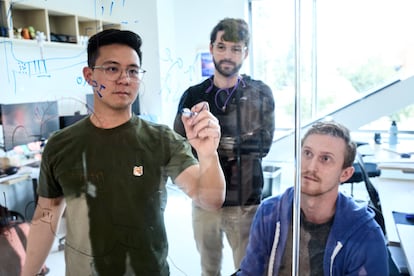New technique opens the door to large-scale DNA editing to cure diseases
The tool offers the possibility of modifying larger regions of the genome with a lower risk of side effects, but at the moment it has only been tested in bacteria

Gene editing allows a person’s genome to be rewritten to correct errors that cause diseases. This is what has been achieved with sickle cell anemia, a disease caused by a mutation that causes red blood cells to be sickle-shaped instead of round. This deformation prevents the cells from properly circulating through the blood vessels, causing severe pain and premature death. In December 2023, the United States approved the first treatment for this hereditary disease made with the CRISPR gene editing system. These molecular scissors make it possible to replace the defective gene that produces hemoglobin — the protein that transports oxygen in the blood — with one that works correctly.
This technology has many applications — with uses in hereditary genetic diseases to cancer immunotherapy — but it has some problems with precision, such as mistakenly cutting sequences similar to the target that is to be eliminated, or releasing cut pieces of DNA that triggers an immune response that is harmful to the patient. On Wednesday, the journal Nature published two articles describing a new genetic editing mechanism that is potentially more precise and has the ability to introduce long DNA sequences into specific places in the genome.
Researchers have used the ability of what are known as jumping genes (or transposable elements), which can move to different parts of the genome of the cell or even other microorganisms, and play an essential role in evolution and adaptation. For their jumps through the genome, these elements use enzymes — recombinase — which build an RNA bridge between the DNA of origin and that of the place where it is going to be inserted.
According to the researchers, from several academic institutions and universities including Berkeley, Stanford and Tokyo University, these bridges are reprogrammable and can be used to choose the specific site where the desired piece of DNA is to be inserted. This versatility would make it possible, for example, to carry a functional copy of a gene to replace a defective one that is causing a disease, as in the case of sickle cell anemia. In one of the studies, the authors were able to deliver a gene to a region of the genome of the bacterium Escherichia coli with an accuracy of 94% and an insertion efficiency of 60%.
Using this mechanism, a team led by Patrick Hsu, from the Arc Institute in Palo Alto, demonstrated that recombinase could be programmed to reverse, cut or insert personalized DNA sequences in specific regions of the E. coli genome, the model chosen to test the technique. Additionally, researchers identified other RNA bridges in other transposable elements, suggesting that there are several enzymes that would be useful as gene editing tools.
Hsu explains that RNA bridges “offer the unique ability to simultaneously recognize and manipulate two DNA sequences for insertion, excision, or inversion in a single step, opening up new possibilities that are not readily achievable with current CRISPR systems.”
“CRISPR requires cellular DNA repair after making a cut, whereas ‘bridge editing’ can perform DNA recombination without requiring cellular DNA repair mechanisms,” continues the researcher, from the University of California, Berkeley. “This could potentially lead to safer gene-editing outcomes, because CRISPR cuts can cause large deletions or unwanted translocations at the cut site.”
Lluís Montoliu, a scientist at Spain’s National Center for Biotechnology, who did not participate in the study, agrees that the new technique could have applications beyond CRISPR and modify larger regions of the genome in a safer way, which would increases its therapeutic potential. “Hsu’s laboratory describes a new DNA genetic modification system that makes it possible to overcome the shortcomings of CRISPR-Cas systems, which are very useful for inactivating genes by mutation or for changing or inserting/deleting a few nucleotides (letters) in the genome but clearly ineffective for supporting, at a clinical level, the insertion, deletion or inversion of large DNA sequences, which are usually present, as chromosomal alterations, in many diseases of genetic origin,” he says.
When it comes to its limitations, Montoliu points out that the system is still “associated with modifications in other similar places in the genome and with a variable efficacy, between 5% and 99%, with a very wide range of response.” He believes, however, that the efficacy “will surely improve with the future optimization of the system.” Another limitation he sees is that “the experiments are only reported in bacteria, and we do not know if it will work in mammalian cells.”
Sign up for our weekly newsletter to get more English-language news coverage from EL PAÍS USA Edition
Tu suscripción se está usando en otro dispositivo
¿Quieres añadir otro usuario a tu suscripción?
Si continúas leyendo en este dispositivo, no se podrá leer en el otro.
FlechaTu suscripción se está usando en otro dispositivo y solo puedes acceder a EL PAÍS desde un dispositivo a la vez.
Si quieres compartir tu cuenta, cambia tu suscripción a la modalidad Premium, así podrás añadir otro usuario. Cada uno accederá con su propia cuenta de email, lo que os permitirá personalizar vuestra experiencia en EL PAÍS.
¿Tienes una suscripción de empresa? Accede aquí para contratar más cuentas.
En el caso de no saber quién está usando tu cuenta, te recomendamos cambiar tu contraseña aquí.
Si decides continuar compartiendo tu cuenta, este mensaje se mostrará en tu dispositivo y en el de la otra persona que está usando tu cuenta de forma indefinida, afectando a tu experiencia de lectura. Puedes consultar aquí los términos y condiciones de la suscripción digital.
More information
Archived In
Últimas noticias
Most viewed
- David King, chemist: ‘There are scientists studying how to cool the planet; nobody should stop these experiments from happening’
- Reinhard Genzel, Nobel laureate in physics: ‘One-minute videos will never give you the truth’
- Mexico completes its trade shift with the entry into force of tariffs on China and countries without trade agreements
- Oona Chaplin: ‘I told James Cameron that I was living in a treehouse and starting a permaculture project with a friend’
- Sinaloa Cartel war is taking its toll on Los Chapitos











































